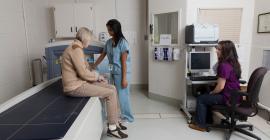
Key Osteoporosis Info
Why the CBMD Program Is Needed in Ontario
Osteoporosis is a disease characterized by low bone mass and deterioration of bone tissue. This leads to increased bone fragility and risk of fracture (broken bones), particularly of the hip, spine, wrist and shoulder. Osteoporosis is often known as "the silent thief" because bone loss occurs without symptoms.
“People are needlessly experiencing pain, fractures and even death due to osteoporosis, a disease that could be treated if people were more aware of the risk factors and symptoms. Osteoporosis is a terrible and debilitating condition, which millions of people are affected by.”

Important Facts About Osteoporosis
- Osteoporosis is a condition that causes bones to become thin and porous, decreasing bone strength and leading to increased risk of breaking a bone
- No single cause for osteoporosis has been identified
- Osteoporosis can strike at any age
- Osteoporosis affects both men and women
- Osteoporosis is often called the ‘silent thief’ because bone loss occurs without symptoms unless one has fractured
- Osteoporosis can result in disfigurement, lowered self-esteem, reduction or loss of mobility and decreased independence
- Women and men alike begin to lose bone in their mid-30s; as they approach menopause, women lose bone at a greater rate, from 2-3% per year
- Risk factors include age, sex, vertebral compression fracture, fragility fracture after age 40, either parent has had a hip fracture, > 3 months use of glucocorticoid drugs, medical conditions that inhibit absorption of nutrients and other medical conditions or medications that contribute to bone loss

Important Facts about Ontario BMD Services
- BMD is among the top fifteen diagnostic imaging examinations ordered by Ontario physicians
- Only medical specialists, the majority of whom are radiologists, along with some nuclear medicine physicians, endocrinologists and rheumatologists, report BMD
- Approximately 600 Ontario radiologists are reporting BMD
- Only medical radiation technologists (MRT) may perform BMD testing
- Approximately 800 MRTs are performing BMD
- There are approximately 325 DXA units in Ontario hospitals and clinics
- Close to one-third of Ontario DXA units are accredited
- Approximately 300,000 procedures are performed annually
- Approximately 175,000 scans are provided at CBMD accredited sites
- Major decrease in the number of low risk BMD services since 2008 are due to OHIP rule changes
- There is growing evidence of need to diagnose at risk male and paediatric patients
- The overall yearly cost to the Canadian health care system of treating osteoporosis and the fractures it causes was over $2.3 billion as of 2010. The cost includes acute care costs, outpatient care, prescription drugs and indirect costs. This cost rises to $3.9 billion if a proportion of Canadians were assumed to be living in long-term care facilities because of osteoporosis
- Each hip fracture costs the system $21,285 in the first year after hospitalization





